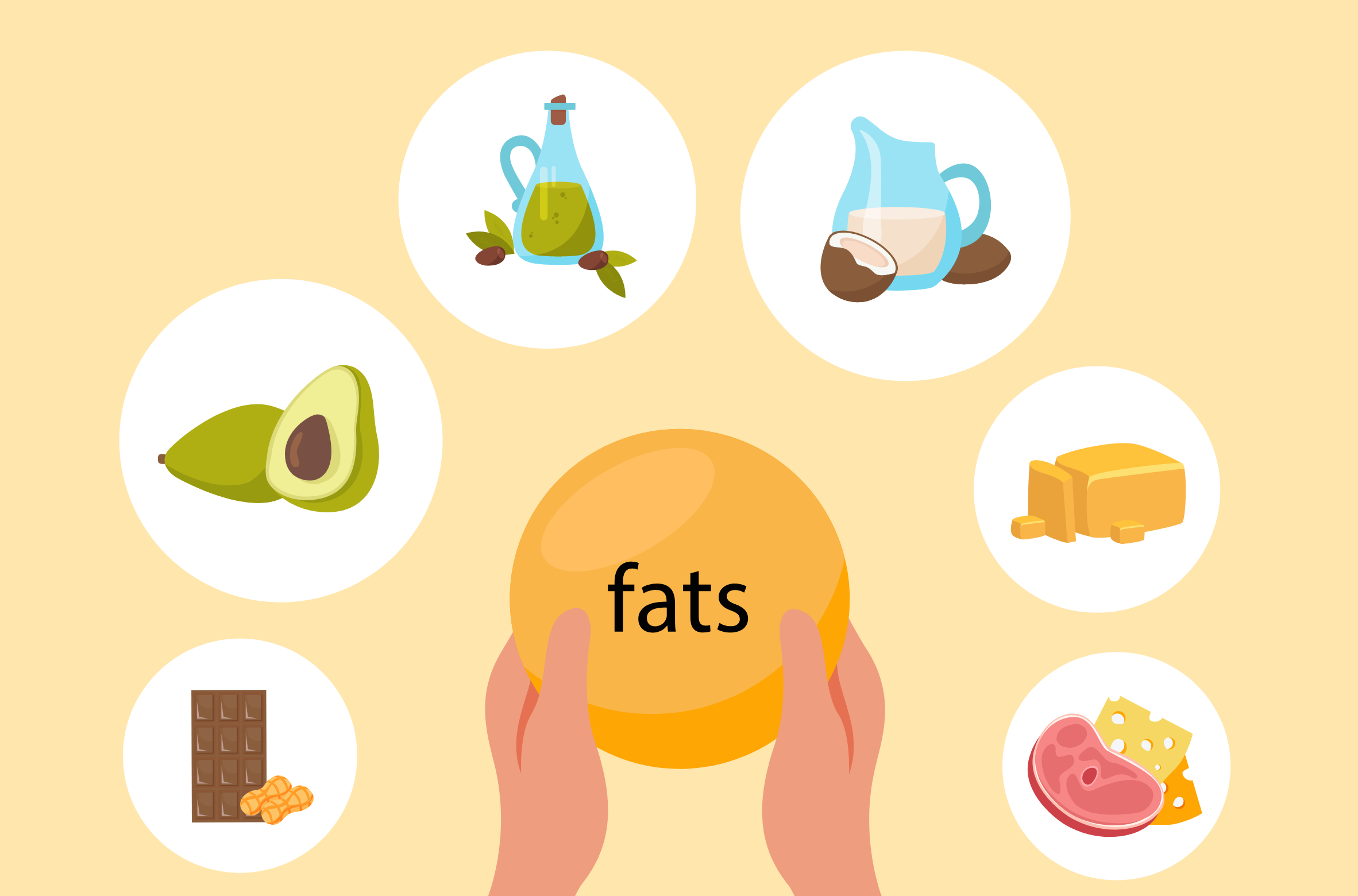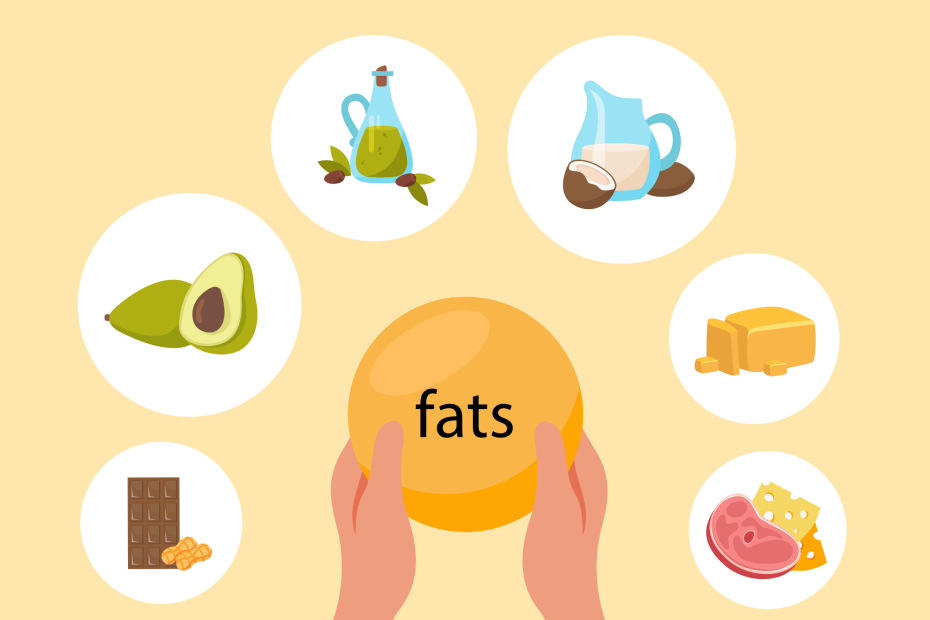Fats
- The three types of fats are saturated, unsaturated, and trans fats.
- All fats contribute 9 calories per gram.
- Trans and saturated fats should be limited in our diet, and unsaturated fats are encouraged.
- Omega-3 and omega-6 fats are essential types of unsaturated fats.
- Most people should consume more omega-3 fats.
- See the last page for a list of foods containing each type of fat.
Fats, sometimes referred to as lipids, are one of the three macronutrients, next to carbohydrates and proteins. In years past, fats were given the reputation of being the enemy of our diet, but some fats are essential, meaning if we don’t consume them, we will die! Fats can be classified into three main categories: saturated, unsaturated, and trans. These titles refer to a characteristic of the fat’s chemical structure, and unsaturated fats can be further divided as poly-unsaturated and mono-unsaturated fats.
All fats contribute 9 calories per gram, as opposed to carbohydrates and proteins that only contribute 4 calories per gram. It is recommended that about 25-35% of one’s calories should come from fat, which for an average diet of 2,000 calories per day is about 500-700 calories or 56-78 grams of fat. For reference, there are about 8 grams of fat in a cup of whole milk and about 43 grams of fat in an 8 ounce steak. There are also recommendations for the types of fat we consume. We should aim for 0% of our calories to be from trans fat, no more than 10% of our calories from saturated fat, and there is no limit on the amount of unsaturated fat we should consume. Keep reading to learn more about the ban on trans fats, why we should limit saturated fats, and the benefits associated with unsaturated fats. Lastly, there is a list of food sources for each type of fat.
Trans Fat Ban
Until a ban in 2015, trans fats were often added to foods to improve their taste, texture, and shelf life. The Food and Drug Administration, or FDA, is responsible for monitoring and ensuring the safety of the United State’s food supply, and in 2015, the FDA banned the addition of trans fats to foods. It was found that trans fats directly increase LDL, or “bad” cholesterol, greatly increase a person’s risk for heart attack or stroke. Additionally, the consumption of trans fats was strongly linked to the development of atherosclerosis. Atherosclerosis is the name for the formation of plaque in blood vessels which can physically block blood flow leading to heart attack or stroke.
- Can I still find trans fats in my diet? Some cooking methods, like deep frying, create trans fats. Since this is unavoidable in the cooking process, we should avoid or minimize the consumption of deep fried foods to reduce our intake of trans fats. Similarly, oil that is re-used in cooking tends to have a higher trans fat content compared to new oil.
Saturated Fat
The recommendation that we should consume no more than 10% of our daily calories from saturated fat has a historical foundation. In the 1950s there was a huge increase in cardiovascular disease, or heart disease, which called for scientific investigation. At the time, scientists predicted that consumption of saturated fats caused heart disease, and there studies that supported this hypothesis were highlighted, whereas studies that showed the opposite were brushed aside. To this day, there is conflicting data on how much saturated fat can affect one’s risk for heart disease, however the recommendation of no more than 10% of our daily calories from saturated fat persists.
Saturated fats are known to increase LDL, or “bad” cholesterol, in the blood, similar to trans fats. More LDL raises the risk for heart disease, so it makes sense that saturated fat is thought to increase the risk for heart disease. However, there is debate whether reducing saturated fat in the diet will actually lead to any reduction in heart disease risk. This is because of the type of LDL saturated fat affects. There are two types of LDL, small LDL and large LDL. Saturated fats affect the number of large LDL, which have a much weaker association with heart disease risk compared to small LDL.
- What to do? Although the data is conflicting, diets that are naturally lower in saturated fats, like the Mediterranean diet, tend to lead to better health outcomes. It is hard to say what is causing better health outcomes in these diets – is it the decrease in saturated fat or the increase in fruits and vegetables or something else completely?
- Do not replace saturated fats with added sugars. If you are looking to reduce your saturated fat intake, be careful not to replace it with added sugars. Added sugars, which include table sugar, brown sugar, honey, syrups (maple syrup, high fructose corn syrup, and flavorings added to beverages), and any other sugar that is not naturally found in a food, increase the risk of heart disease more than saturated fat.
- Replace saturated fat with unsaturated fat. Unsaturated fats are associated with many positive health outcomes and are encouraged in the diet. Some foods that contain unsaturated fat are avocados, olive oil, and nuts. See below for a detailed list of unsaturated fat food sources.
- Identifying saturated vs unsaturated. At room temperature, saturated fats are usually solid, like butter or the marbling on a steak, whereas unsaturated fats are usually liquid like olive oil and vegetable oil.
Unsaturated Fats
Unsaturated fats are where we can find the essential fats. Within the category of polyunsaturated fats are omega-6 and omega-3 fats, which are required for our survival. Omega-6 fats are abundant in the western diet and found in foods like soy, sunflower, and corn oils. Many ultra processed foods use oils that contain omega-6s, so most people consume enough of them. On the other hand, omega-3s are found in foods like fish and walnuts, and most people do not consume enough of them. The ratio of omega-6 to omega-3 fats in the diet has been associated with health outcomes. On average, people tend to consume a ratio of 10:1 for omega-6 to omega-3 fats, meaning for every 10 grams of omega-6 fats, people consume only 1 gram of omega-3 fats. The optimal ratio for improved health outcomes is 4:1, or even as low as a 1:1 ratio, of omega-6 to omega-3 fats, meaning for every 4 grams of omega-6 fats, people should consume 1 gram of omega-3 fats – in other words, we need to consume more omega-3 fats. Generally, we should aim to consume about 6-10 grams of omega-3 per week, which could be found in 2-3 servings (4-5 ounces) of salmon. The ratio of omega-6 to omega-3 fats in the diet are relevant when we think about the roles of these fats in the body.
- When a body faces injury, whether inside the body or on its outer surface, it responds with an inflammatory response. During the inflammatory response, omega-6 fats work to amplify the inflammation signal, whereas omega-3 fats amplify an anti-inflammatory response and recruit molecules to resolve the inflammation. Since we cannot make omega-6 or omega-3 fats, the composition of the fats inside our body is based solely on the composition of the fats in our diet. If we consume a lot of omega-6 fats and only a few omega-3 fats, our inflammatory response will heavily amplify the inflammation signal and the anti-inflammatory and resolving activities of omega-3 fats will be small. Chronic and excess inflammation can be harmful and is associated with a number of diseases. Since omega-3 fats have an anti-inflammatory effect and actively resolve the inflammation, omega-3 fats may protect from a number of diseases and improve general health outcomes.
- Brain health. Omega-6 and omega-3 fats are very important for brain development and health over one’s lifespan. Not only do they exert their inflammatory effects in the brain, but they also impact the transmission of signals in the brain. Omega-3 fats are especially important during brain development during pregnancy, after birth, and in childhood.
Take Home Message
Fat is a macronutrient made up of saturated, unsaturated, and trans fats. Not all fats are created equal – consumption of trans fats definitely increases our risk for heart disease, saturated fats might increase our risk for heart disease, and unsaturated fats decrease our risk for numerous diseases. Omega-6 and omega-3 fats, which are types of unsaturated fats, are essential to our survival. However, most people could consume more omega-3 fats, which would be beneficial for inflammation and brain health.
Test Your Knowledge
How do omega-3 fats impart effects during an inflammatory response?
- Omega-3 fats cause more inflammation
- Omega-3 fats cause anti-inflammatory effects and actively resolve inflammation
- Omega-3 fats do not impart any effects during inflammation
- Omega-3 fats destroy omega-6 fats
Correct answer: b) Omega-3 fats cause anti-inflammatory effects and actively resolve inflammation
Explained: Omega-3 fats cause anti-inflammatory effects and actively resolve inflammation. On the other hand, omega-6 fats cause more inflammation. Omega-3 fats do not affect omega-6 fats, meaning they do not destroy them.
Fat Sources
Below is a list of foods within each type of fat category.
| Trans | Saturated | Unsaturated | |
| – Commercial baked goods: cakes, pies, pastries, cookies
– Microwave popcorn – Fried foods – Shortening |
– Beef
– Cheese – Butter – Whole fat milk and ice cream – Cured meats: salami, pepperoni, prosciutto – Pork, bacon, and sausage – Cream cheese – Sour cream |
Omega-6 | Omega-3 |
| – Sunflower, safflower, soy, sesame, and corn oils
– Corn chips – Peanut butter – Cakes and pastries – Sunflower seeds – Pumpkin seeds – Walnuts |
– Salmon
– Tuna – Herring – Mackerel – Chia seeds – Walnuts |
||
References
- Astrup A, Teicholz N, Magkos F, et al. Dietary Saturated Fats and Health: Are the U.S. Guidelines Evidence-Based? Nutrients. 2021;13(10):3305. doi:10.3390/nu13103305
- FoodData Central. Accessed January 30, 2023. https://fdc.nal.usda.gov/fdc-app.html#/food-details/172164/nutrients
- Astrup A, Magkos F, Bier DM, et al. Saturated Fats and Health: A Reassessment and Proposal for Food-Based Recommendations. J Am Coll Cardiol. 2020;76(7):844-857. doi:10.1016/j.jacc.2020.05.077
- Nutrition C for FS and A. Trans Fat. FDA. Published online January 25, 2022. Accessed January 30, 2023. https://www.fda.gov/food/food-additives-petitions/trans-fat
 share
share



